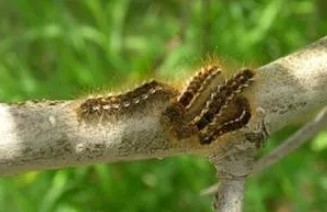From NH Forest Health Bureau: Browntail moth caterpillar winter webs have been located and removed at the Isles of Shoals off of the New Hampshire coast, the N.H. Forest Health Bureau announced today. This is the first confirmed incident of the species in the Granite State in 75 years.
“We’ve been monitoring an infestation of browntail moth over the last decade as it expanded to most of southern Maine,” said Kyle Lombard, administrator of the N.H. Division of Forests and Lands’ Forest Health Bureau.
“While this first appearance in New Hampshire is offshore, now is the time for everyone to keep an eye out for these caterpillars because they can create uncomfortable and sometimes even dangerous health risks for some people.”
Browntail moth caterpillars have poisonous fine hairs that can produce skin rashes similar to poison ivy, even when the exposure to them is airborne. Inhaling the hairs can also cause serious respiratory issues in some individuals. People should not handle the caterpillars without wearing proper gloves and, when possible, a mask.
Caterpillars can be identified by their dark brown coloration, fuzzy appearance and two conspicuous red-orange dots on their tail end.
While oak and apple trees are primary hosts for browntail moth caterpillars, winter webs can also be found in coastal shrubs like beach plum and cherry, as was the case at the Isles of Shoals.
The winter webs are small, tight clumps on two or three leaves at the tip of a branch and tend to be completely enclosed in silk. They form in the fall and can be removed any time between November and mid-April.
Browntail moth webs differ from those of fall webworm, which are built into big nests in large areas of foliage in autumn. The webs of another commonly found species, the eastern tent caterpillar, are also large but only occur in spring.
Native to Europe, the browntail moth was accidentally introduced to North America in the late 1800s, eventually spreading to all New England states, New Brunswick and Nova Scotia. Massive federal work projects in the 1920s and 1930s, in cooperation with biocontrol research, reduced the infestation area to a small region along the Maine coast. In 2022, it was found in more than 150,000 acres, mostly in the southern half of the state.
For more information about how to identify browntail moth caterpillars and their webs, and to report any sightings, visit nhbugs.org.


 Return to the Concord Monitor
Return to the Concord Monitor